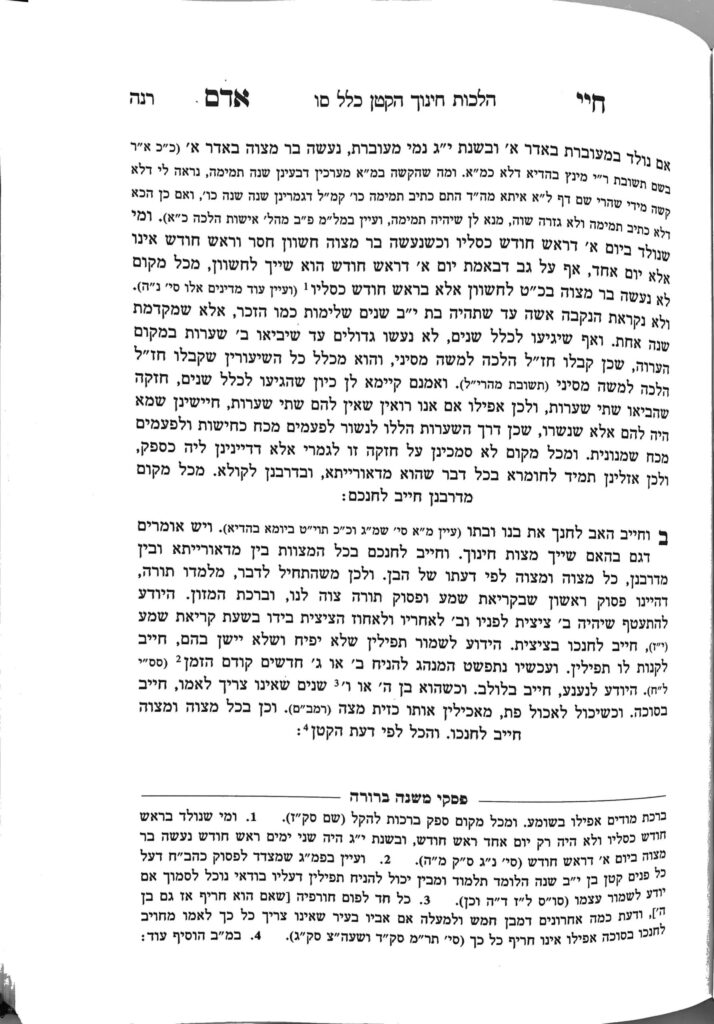We have finished siman 2, in which the Chayei Adam listed some examples of the proper age to begin chinuch in specific mitzvos. We have discussed the examples of lulav, talmud torah, birchas hamazon, brachos in general, kiddush, shema and tefillah. Today, we will discuss netilas yadayim; specifically what we know as negel vasser.
There are two and a half reasons why we wash our hands in the morning. The Gemara mentions a concept of tumah on the body which is created due to the neshama leaving the body during sleep. When the neshama returns in the morning, the tumah leaves, but leaves a residue in the fingers known as ruach raah. It is not bona fide tumas meis, but it is akin to it.
Another reason why we wash is because Chazal instituted that one should wash their hands in the morning. The Rosh understands that this washing is a part of the process of tefillah. The Rashba disagrees, and understands it as akin to the kohenim washing their hands and feet in the morning before entering the beis hamikdash, as a part of preparing themselves for another day of serving their creator. Similarly, we wash our hands in the morning to signify that we dedicate the day to the service of Hashem. This is only a half different reason, as that everyone agrees that the washing is done for preparation for avodas Hashem, but just with different understandings of which avodas Hashem (either tefila(Rosh), or the general service of a day(Rashba)).
Parenthetically, the practical difference between the Rosh and Rashba is mincha and maariv. According to the Rashba, this process is unique to the beginning of the day and would not apply to mincha or maariv (unless one knows their hands are dirty). According to the Rosh, this process would apply to every tefillah. Also, according to the Rosh, one would never need to use a kli, nor do they need to wash three times, because the washing is for cleansing. According to the Rashba, one needs a kli to approximate the way it was done in the beis hamikdash. (although one needs a kli one does not necessarily need to wash three times.) However, according to both opinions, the first reason, for removing the ruach raah, will automatically necessitate washing three times in the morning with a kli .’
Regarding a katan, there are two questions to discuss. First, we need to discuss whether there is a chiyuv chinuch based on the reasons of the Rosh and Rashba. Even if there is no chiyuv chinuch based on their reasons, we need to discuss whether there is a chiyuv chinuch regarding the ruach raah.
Regarding the Rosh and Rashba, one can argue that since this washing is associated with tefillah (more loosely according to the Rashba but nevertheless connected), the chiyuv chinuch only starts once the child has reached the age of chinuch.
Regarding the removal of ruach raah, we will need to learn a part of the Shulchan Aruch Harav, written by the Baal Hatanya. The Baal Hatanya wrote on all four parts of halacha. He then began a mahadura tinyana (second edition), but we only have the first four simanim of Orach Chayim extant. Interestingly enough, it is now published in front of his first edition, even though it is really the second edition of his peirush. Be’ezras Hashem, tomorrow we will learn what he writes regarding this question.
Summary
Netilas yadayim in the morning is performed
- due to the ruach raah which remains on our hands from the night.
- Additionally, according to the Rosh, it is performed as a preparation for tefillah, and according to the Rashba, it is performed as a preparation for a day of avodas Hashem.



